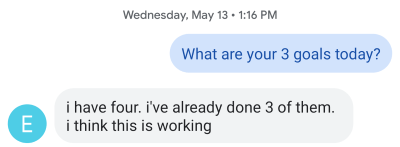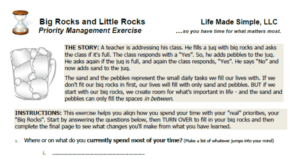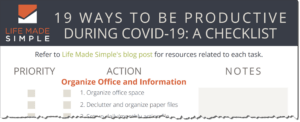
by Lori Vande Krol | Sep 3, 2020 | Goals and Priorities, Habits, Motivation, Procrastination
I have something to confess – I have been a pretty bad cook most of my life. I don’t enjoy it and although I knew my family could be eating healthier, better-cooked meals, I’ve never really had an interest in learning – until recently. For a few reasons I’ll get into later, I decided I would challenge myself to learn how to feed my family in a “cleaner” way. Questions that crossed my mind were: “Where do I start? Do I have the right equipment and tools? Where do I get my groceries? How do I know what “eating clean” means? Will the family like the meals? How much time will it take? Will it even help? How can I change habits after so many years of doing it a different way?” There were a lot of unknowns for me and it was a little scary getting started.
Below I share my process and how you can use this same process to change any habit. It’s never too late to learn and grow!
Know Your “Why” for a Habit Change
Sometimes the most difficult step in changing a habit is deciding to do so. In her book Better Than Before, Gretchen Rubin states “A habit requires no decision from me, because I’ve already decided” (Rubin, 2015, p. 5). But even if you have made the tough decision to work on a habit, change is hard. It’s easy to quit. Things often get harder before they get easier. That is why it is important to be clear about your “why” for learning something new or changing a habit. Your “why” needs to be important enough to drive you to start and to continue when things get rough, which I guarantee they will.
Recently in my work with a client, she shared how she had been struggling with changes in daily working habits. Some days were so mentally draining she would have to take a nap to keep going. We reviewed her “why” and decided she would post a photo or vision board near her desk that reminded her of it daily. Doing this helped her to make better choices, focus her work, and maintain energy to reach her goals.
I have several “whys” for changing the way that I shop, cook, and eat, a few of which include increased food sensitivities in the family, a need to eat well to support exercise and sports, setting a good example for my children to be as healthy as possible, and to challenge myself to learn something new during some Covid-19 related downtime. I was also motivated by the short time I had to put new habits in place before the inevitable craziness that comes with back-to-school activities. All of these “whys” were strong enough priorities to spur me into action and to keep me going on the toughest days.
Research and Find the Best Tools to Support Your Habit
Before choosing the right tools to support your habit, it’s important to be clear on your vision for success and what is needed to help you get there. Will your new habit require enhancements to your current tools and systems or the need for something new? For example, if you are wanting to exercise at home regularly, what type of exercise will help you reach your goals? Do you have the right equipment available?
Or maybe you have decided to create a better habit of planning and scheduling your week. Do you prefer doing so in a paper or digital format? What features does your tool or process need to offer the best chance at success? It is important to analyze your needs and preferences before deciding on the tools that will best support your new habit.
I knew I didn’t have the systems, tools, or knowledge to change our cooking and eating habits on my own. If I was going to be successful, I needed to research and educate myself. I started by Googling “clean eating for families” and reached out to an exercise group I belong to. My research led me to Momables.com and the 30-Day Family KickStart program, which is a 4-week sugar-free, gluten-free, and dairy-free (optional) clean eating program. Momables provided me with weekly menus, shopping lists, and preparation tips. In addition, the program suggested equipment and tools that would support my new habit as well as general education about clean eating.
Find Support and Accountability to Reach your Goals
Creating new habits can be lonely without the right people to support and provide you with accountability and motivation. I found this in a few ways:
 (1) I ensured my family was on board with the new eating plan. If I didn’t have their support, it would not have worked.
(1) I ensured my family was on board with the new eating plan. If I didn’t have their support, it would not have worked.
(2) The creator of Momables, Laura Fuentes, reached out to let me know she was available for any support needed. Her regular email communications also kept me on track and motivated me to continue.
(3) The exercise group I belong to often discusses the need for clean eating to support any training or workouts. Hearing others’ challenges and successes provided motivation when things were hard.
Who can provide you with the support, motivation, knowledge, and accountability you need to succeed in your journey to learn, grow, and develop new habits?
Celebrate and Maintain Your Success
Once you have reached your goal, it is important to recognize it. Celebrate your accomplishment, and then determine how you will maintain your success. My family and I planned two celebrations during our 4-week challenge – after two weeks, we enjoyed s’mores by the fire as a “cheat” night. After we completed the full plan, we celebrated with a trip to the local ice cream shop. Knowing we had these milestones scheduled – that we would be able to enjoy a sugary treat soon – helped to keep us on track the rest of the time.
 Now that we have completed the 4-week kickstart program, we have set a goal to maintain an “80%” clean-eating habit. With the help of a weekly dinner plan from Momables, I now have the knowledge, tools, and resources to continue this new lifestyle. We know we won’t be perfect and I would be crazy to think we are “cured” from sugary foods for good, but we have created healthier habits that we will be able to maintain going forward.
Now that we have completed the 4-week kickstart program, we have set a goal to maintain an “80%” clean-eating habit. With the help of a weekly dinner plan from Momables, I now have the knowledge, tools, and resources to continue this new lifestyle. We know we won’t be perfect and I would be crazy to think we are “cured” from sugary foods for good, but we have created healthier habits that we will be able to maintain going forward.
Depending on the habit or change you work to develop, you may not be perfect all of the time and that’s okay. What is important is that you have systems in place to maintain what you have started and can get back on track quickly and easily. Don’t be too hard on yourself and be sure to celebrate the wins.
A Process for Changing or Forming a Habit
After 20 years of the excuses “I hate to cook” or “I don’t know how to cook” as a reason for not learning how to do better, I am proof that it is never too late to learn and change. The techniques and knowledge I gained over those 4 weeks have provided me the basis I need to continue with better habits for myself and my family. Whatever it is you feel you could do better, decide to do it, and then follow this process for success:
- Know your “why”
- Research and find the best tools
- Find support and accountability
- Celebrate and maintain your success
Please share your goals and progress. And if you need assistance with the process, don’t hesitate to reach out for coaching support.
Learn more about Life Made Simple’s Productivity Coaching Plans.
Sources:
Rubin, Gretchen. Better Than Before. New York: Broadway Books, 2015. Print. p. 5.
Momables. www.Momables.com/. Accessed August 2020.

by Lori Vande Krol | May 21, 2020 | Motivation, Procrastination, Task and Project Management, Time Management
“I have so much to do and I just can’t make myself do anything.” This is what I heard from my teenage daughter last week when I walked into her bedroom. Emma is a junior in high school and was trying to juggle three college placement tests, preparation for two choir auditions, and homework for four classes, all on her own and online due to Covid-19. I immediately put on my “productivity consultant hat” and asked her, “Have you made a list? Did you schedule everything into your bullet journal? Are you focusing on what has to be done this week?” She continued, “I’ve done all the things, mom, but nothing is working.”
Do you ever feel overwhelmed by a lengthy to-do list, and all of it feels of equal importance? Sometimes we can feel so much anxiety by looking at our many to-do’s that we don’t know where to start, and the methods and habits that have worked in the past just aren’t working now. Below I share a couple of quick tips to help you get through the most overwhelming of times.
Choose One Thing to Focus on Right Now
Continuing with the example of my daughter’s stressful situation, I asked her, “Why don’t you choose three things to focus on and forget about the rest? Just work to check those off your list one by one to feel a sense of accomplishment.” I knew that once she got those first three things done, she would feel a little better about moving to the next on her list. After hearing that she had also tried this “trick” and it still didn’t kick-start her motivation, I left her with, “Okay, turn on your relaxing music, chose one thing to do right now, and then we will talk again.”
During the most stressful times, you may need to pare back to the most basic productivity strategy – choose just one thing to focus on right now. Ask yourself, “What is the next action I need to take to move a project or task forward?” Do that and then find the next thing to focus on. Soon you should start to feel a sense of control over your to-do’s, your stress levels will decrease, and you can work to get a better handle on the rest of your list.
Choose Three Things to Focus On Today
Later that morning, Emma explained that she had been thinking about the “choose three things” method and wondered if it hadn’t worked in the past because she didn’t write her goals down – instead, she had just determined in her head what three tasks she would do. I told her I would check in with her via text for the next few days to remind her to write down her three goals and check on her progress. Here was the first day’s response:

Success! At least for that day. This extra act of writing down her goals added to the intentionality of the actions and was just enough to get her over her productivity hurdle. The next day’s text was answered with a list of her three goals for that day. Emma may not continue this habit every day moving forward. Instead, she will likely go back to her normal method of weekly planning in her bullet journal. But it was what she needed to get through the high stress levels she was encountering at that time.
When to Use This Simple Process for Increased Productivity
As discussed, using the process of choosing three goals each day is a great tool during times of high stress or feelings of extreme overwhelm. This is also a great process to use if you haven’t yet developed a weekly and/or daily planning habit. Begin with a brain dump of all of your to do’s. Get them off your mind and on paper, or in digital form. Prioritize them if you can. Then, each morning choose three goals to focus on that day.
- Each morning, choose three things you will accomplish today.
- Write them down. Consider sharing them with someone.
- Get to work!
What’s Next?
Once you complete your three goals for the day, celebrate, and then choose the next 1-3 actions. Soon you will have more control and a better perspective of your to-do’s. When you are ready to move to the next level of weekly and daily planning, take a look at “What Should I Do Right Now?” for additional planning tips.
If you struggle with goal setting, prioritization, planning, or are just feeling overwhelmed with work and life, please reach out to me or schedule your free 30-minute Productivity Assessment. I would love to help you gain control and develop the habits that save you time, energy, and stress.

by Lori Vande Krol | Apr 23, 2020 | General Productivity, Motivation
One of the most controversial topics I’ve posted on social media has been whether or not it is important to make your bed every morning. I admit to not being a daily bed-maker (sorry Mom) and was excited to share this article by Tim Denning backing up my decision, albeit written more aggressively than I would have (e.g.“This is stupid advice. Don’t follow it.”) But I do appreciate the author’s point of view to focus on larger tasks first thing in the morning before you are worn out by the day’s events. Mr. Denning argues that making your bed won’t change the world, but other tasks can. My post was met with support by fellow “non-bedmakers” including successful leaders I think highly of. But I also heard from “daily bedmakers” I respect and admire, including my mother, who are passionate about their decision and reasons for making their beds daily.
During a 2014 commencement speech given at the University of Texas by Naval Admiral William H. McRaven, Admiral McRaven explained the importance of a perfectly made bed during basic SEAL training. He ended this section of his speech with, “If you want to change the world, start off by making your bed.” Honestly, who am I to argue with the former commander of the U.S. Special Operations?
How then, can these completely opposing views about the importance of this simple task in our daily lives both be right? Let’s dig a little deeper.
Why You Might Make Your Bed Every Day
An unofficial poll on one of my social media accounts gathered several comments as to why the “bed-makers” take the time each day:
- “Starting out the day with a simple completed task sets me up to do better during the day. If I don’t do that first task then pretty soon everything just feels overwhelming so why do anything.”
- “I think [not making your bed] sets up for a too relaxed way of living.”
- “I love the feeling of coming into my bedroom and having everything clean and nice looking. I feel like it helps my mind relax at night and feel less cluttered.”
- “It’s a simple thing I can do while my brain is still fuzzy (and not yet ready to tackle big things) and it sure feels good later in the day.”
- “The best part of making the bed is climbing into a nice crisp bed at night. I don’t want YESTERDAY covers!”
But what if this isn’t true for all of us? Let’s take a look at the other side of the story.
Why I Don’t Make My Bed
I was brought up to feel that making my bed was just part of the daily routine – you shower, get dressed, brush your teeth, and make your bed. So as a young adult, I continued to make my bed every day. But then I got married and my husband didn’t make the bed. When I asked if he would chip in every once in a while, he told me, “I don’t make the bed. My grandma taught me it needs to air out.” What? At the time, this sounded like an interesting made-up reason to not take responsibility, but I’ll get back to that. Without my spouse taking on his share of the task, I started to wonder how important it really was and soon began to periodically skip this daily activity.
Then I had children, started my business, and began working at home. I found that I could spend half of my day picking up and cleaning the house before I even “got to work.” I had to discipline myself to let some of it go, and bedmaking became one task I was okay giving up. Today, I make the bed fully only when someone is coming over, on cleaning days, and on rare days when “I just feel like it.” Most days, I just throw the comforter up over the pillows and call it good.
What I found over time is that it really didn’t matter. I could walk out of the bedroom and into my office and feel just as productive whether I made my bed or not. But recently, during the COVID-19 quarantine, I learned I have a different “productivity trigger” when working from home. I need to wear makeup. I learned this when my daughter walked into the bathroom while I was getting ready for the day and said, “Why are you putting makeup on?” I responded, “For you guys, I guess.” As I thought more about it, I realized my family doesn’t care if I wear makeup (they’ve seen me at my worst), but I do. Putting on just a minimal amount helps me to feel more awake and energized which leads to more productivity.
Obviously wearing makeup isn’t going to be the trick for everyone – we are all motivated and energized by different things. If you can’t jump immediately into a “change the world task” first thing in the morning, as Tim Denning suggests in his article, what small action can you take each day to increase your energy, motivation and productivity? Perhaps it is making your bed or putting a little makeup on. Or it may be something completely different such as a morning jog, journaling, or meditation.
Read The Following At Your Own Risk
A few years ago, I decided to look into my husband’s claim regarding beds needing to “air out” each day and guess what? There is actually some truth to it. You may regret reading what follows, so continue at your own risk. The article The Reason Scientists Say You Shouldn’t Make Your Bed cites research from a 2015 Kingston University study when it states “making your bed in the morning traps in dust mites that have accumulated overnight and provides a breeding ground for allergens that can exacerbate asthma and allergies.” I’ll spare you the more gruesome details (check out the article for this), but according to the Simplemost.com article, making your bed first thing in the morning traps in moisture, allowing your bed to be a home for up to 1.5 million dust mites. If you leave your bed messy, however, the mites are exposed to air and sunlight, which causes them to become dehydrated and die out. So for those that are not daily bed-makers, you may actually be healthier because of it.
What Works For You?
I’d love to hear what is or is not included in your morning routine that helps you have a more productive day. Has your time at home during COVID-19 changed your morning routines or habits? Share a comment below or reach out via email.

by Lori Vande Krol | Mar 24, 2020 | Email, Goals and Priorities, Organization, Task and Project Management, Technology, Time Management, Tools
The past several weeks with the coronavirus pandemic have been unprecedented. We are in an environment of fear, stress, uneasiness, and unknowns. While it will take time for us to work through these emotions, it is important that we also try to continue as normal in ways that we can control. Productivity expert Barbara Hemphill said, “Control the things you can, so you can cope with the things you can’t.” I think this is true now more than ever.
19 Productive Actions You Can Control
One byproduct of social distancing is that many of us have found ourselves with unexpected time on our hands – closings, canceled events and appointments, reduction in travel time on planes, trains, and cars, and for some, an unfortunate reduction in customers or client work. Why not utilize this time for tasks or projects you have been putting off or just haven’t had the time to address? Take some control by working on things that will strengthen and grow your business, your career, and/or yourself, and create a solid base for “after the virus.”
Below I share a list of 19 productive actions you can take now, along with tips, resources, and recommended tools to assist with the task. Don’t be overwhelmed by the length of the list. Instead, choose a few of the highest priority items for you and/or your business and focus on taking action on those first.
At the end of the article, I provide a free download that will allow you to more easily prioritize each item and track your progress.
Disclaimer: Life Made Simple sometimes partners or affiliates with companies providing products, applications, or services that we feel would benefit our clients. In these cases, we may receive a small commission on sales through our affiliate links.
Organize Your Office Space and Information
1. Organize your office space
Whether you have a room devoted to work or space within another room, a clear, organized area can help improve focus and productivity. Clear off your floor, desk, and other surface areas. Toss, recycle, shred, or donate any unneeded items. Leave out only those items that add to your productivity, peace, or joy.
2. Clean out and organize your paper files
Divide your files into action (items you are working on now) and reference (items you are keeping for tax/legal reasons or future reference). Label files alphabetically (e.g. client files) or topically. If you have more than one file drawer full of paper, consider numerical labels and an online inventory of your paper files using the Paper Tiger filing system.
3. Set up a daily and/or monthly action file system
An action file system such as this one by Smead allows you to file papers or cards by day and/or month as reminders to complete a task or to be easy accessible when you need them. Keep the file system in a desktop file
allows you to file papers or cards by day and/or month as reminders to complete a task or to be easy accessible when you need them. Keep the file system in a desktop file along with a few hanging files to hold quick reference papers.
along with a few hanging files to hold quick reference papers.
4. Declutter and organize your digital files
Depending on your current structure and content, decluttering and organizing digital files can mean something different for everyone. Start with this checklist of things to think about when attacking your digital world and then develop your unique plan.
5. Set up your email for productivity
Like digital file management, email management can differ depending on the application you use (e.g. Outlook or Gmail), how much email you receive daily, and whether you use your email app for other productivity tasks such as calendar, tasks, and contacts. Check out this past blog post to help you get started with The Only 5 Email Folders You Really Need.
6. Go paperless
Moving towards a paperless environment requires a good scanner. My favorite scanner for moving those piles of paper, notes, and business cards to digital form is the Fujitsu ScanSnap. It is the most expensive tool of all of the resources mentioned here, but well worth the cost if you work with a lot of paper, want to be more digital, and/or often work remotely.
7. Manage your contacts
Whether this means scanning or entering business card information, cleaning out old contacts and updating current ones (I use the Duplicate Contacts app for Android and Apple phones – there are many others!), or setting up a full-blown CRM (customer relationship management) system, contact management is a great way to spend some unexpected downtime.
Get Clear on Your Goals
8. Determine your rocks (what is most important)
If it has been a while since you really stepped back to evaluate what is important to you in business and life, this is a great time to get re-centered and focused on what matters most. I am happy to share an exercise I use with individuals and groups for this reason.
9. Develop your 2020 goals
Once you know your “rocks,” you can work to develop your goals for the remainder of the year. I am confident life will get back to normal and when it does, what will you focus on for the remainder of the year? It’s okay if your goals aren’t perfect right now. Just get something on paper and then reevaluate once the pandemic has passed.
Analyze and Manage Your Time
10. Analyze your time management habits
When it comes to time management, have you ever wondered where you excel? And where you could improve? Spend some time looking at your strengths and weaknesses and make a plan for continuous improvement. If you’d like help with this reflection and/or putting systems in place to better manage your time, please contact me. I’d love to help!
11. Start using a daily time management tool
Now may also be the perfect time to review a few different time management tools to see what might work best once we get back to our hectic lives. Of course, my favorite is the ProAction Planner. [Update: Check out this article from Well + Good listing the top planners for 2025.]
Practice Risk Management
12. Back up your files
You have many options for backing up files, photos, email, and other digital information:
13. Evaluate your financial position
For businesses, utilize your current financial tool to review your actual results versus goals to date in 2020. How will this downtime impact your goals, if at all? If you are not using a financial tool, consider implementing one. Quickbooks, Freshbooks, and Xero are popular options. (Before introducing a tool such as these, be sure to do a technology needs assessment to ensure you are choosing the right tool for your needs. Last month’s blog shares a list of things to consider when analyzing a new or improved technology tool.)
Individuals should also review the impact of the pandemic on their financial position and develop a resulting budget and plan for the rest of the year.
Work on Yourself
14. Learn or fine-tune a skill
Skillshare, is a great resource for videos and training resources for a variety of skills. And, the first 2 months are free! A quick search on YouTube or Google will provide many more options.
15. Read a book
While I’m sure you have your own list of “must-read books,” a few non-fiction books I recommend (depending on your need and interests) are:
Building a StoryBrand: Clarify Your Message So Customers Will Listen
Atomic Habits: An Easy & Proven Way to Build Good Habits & Break Bad Ones
Unstoppable: A 90-Day Plan to Biohack Your Mind and Body for Success
I have a long list of recommended fiction books as well. Let me know if you are interested, or share your favorites in the comments below.
16. Get/stay healthy (exercise, meditation, healthy eating)
Getting and/or staying healthy when stuck at home takes a little bit of work. Since my normal workout location is closed, I joined an on-demand site with videos of the classes I normally take and purchased an inexpensive weight set on Amazon.com. Many workout locations and online exercise sites are providing free challenges, workouts, and videos. In addition, you can find several meditation, yoga, and recipe or meal apps in your phone’s app store.
17. Spring clean your home
Okay, I know this isn’t really “working on yourself” but It is a great way to feel better about yourself and your environment, and a clean, clutter-free home can help you feel more productive in your home office. Here are a few Spring Cleaning Checklists to track your progress. I chose to use the third as I felt it was the most inclusive and I liked that it gave me space to add my own tasks.
The Happier Homemaker
Freebie Finding Mom
Imperfect Homemaking
Give Back
18. Send cards, texts, or emails
Make someone feel a little less lonely or just make someone smile with a note of thanks or encouragement.
19. Help others
Giving can be financial, but doesn’t have to be. Drop off needed supplies or other physical donations, safely volunteer your time if you are healthy and able, or donate blood. You might also share your expertise or knowledge to help others in areas of need during this time, as is my hope with this blog. Buzzfeed and PBS share lists of other ways to help during the pandemic. And this article from Bankrate provides a unique idea – giving back utilizing your credit card rewards points.
Free Downloadable Checklist
I realize this is a long list! Not every item will apply or be important to every reader. In order to prioritize and track your unique action list, I am providing a free, downloadable checklist below. Be sure to refer back to this blog for the supporting resource links.
If you are in need of assistance, coaching, or support related to any of these tasks, please reach out via my contact page or by scheduling your free 30 minute productivity assessment. All of my work can be done virtually via phone or video call.
I wish all of you health, safety, love, and peace over the coming weeks and months. Spend time with family, call your friends, give back, focus on you, and control what you can.

by Lori Vande Krol | Feb 17, 2020 | Task and Project Management, Team Productivity, Technology
Unless you completely avoid politics and social media, you have no doubt heard about the “caucus chaos” that recently occurred right outside my door in Iowa. Much of the media has blamed the chaos on a new smartphone app the Iowa Democratic Party implemented to help get results more quickly. Because I have a large interest in the successful selection and implementation of technology, I thought I’d dig into it a bit further. What happened in Iowa is just one very publicized example of what happens daily in companies and organizations that do not take the time to properly analyze their vision and needs when choosing a new technology tool, or to carefully plan for a successful implementation of the chosen system. How could this have been avoided?
What Went Wrong with the Iowa Caucus?
It is true that much of the cause for reporting delays and questions about count accuracy was due to a “coding error” in the Shadow smartphone application that was used by the Iowa Democratic Party (IDP) to report caucus voting results. The error resulted in only partial results being reported. But if you look just a little deeper, there were more underlying issues that can’t be blamed solely on the creator of the application.
Following are additional factors leading to the issues with the Iowa Caucus:
- State campaign finance records show the IDP paid Shadow, the tech company that created the app used in Iowa, more than $60,000 for “website development” towards the end of 2019. Shadow (or what I’ve also seen called the Iowa Reporter App) was a new app, reported to be just 5 months old, and created specifically for reporting of caucus results. This is not enough time to have been developed and fully tested before being rolled out for such a large and public endeavor.
- Once the IDP had the app, there was not enough time for users to learn and test it themselves. In fact, some users weren’t even able to get past the log-in screen.
- This year, a new set of reporting requirements was put in place by the Democratic National Committee. Historically, precincts would only announce the outcome in terms of state delegate equivalents (S.D.E.s). In 2020, precincts were required to report three numbers per candidate: (1) raw vote totals, (the initial alignment), (2) the totals after the shifts of participants from non-viable candidates (the second alignment) and (3) the estimated delegate count for each candidate. While this may be confusing for those not involved with caucus procedure, it isn’t difficult to reason that this increase in requirements, along with the use of a new application, and short time frame for development, training and testing, was the start of “the perfect storm.”
- In addition to the Shadow app, it was reported that there were training issues with other programs needed for efficient reporting of results, including Google Sheets, and problems with 2-factor authorization needed to access those programs.
- The back-up process for reporting results when the app did not work was to call headquarters and manually report results (which is the way it had been done in past years). But, there were not enough lines and/or people to answer these calls and volunteers were left waiting for hours. It was quite obvious the back-up plan hadn’t been fully thought through.
It is my guess that there were more issues involved in the selection and implementation of caucus reporting systems and processes this year. Iowa Democratic Party Chairman, Troy Price, has called for an independent forensic review of the decisions and processes (or lack of processes) that led to the failure. I look forward to learning more from that review.
2020 Iowa Caucus Consequences
What we do know is that there has been some pretty large consequences of the lack of proper analysis, testing, and implementation.
- Chairman Price has resigned as chair of the party after 2.5 years of service, effective as soon as a replacement is elected.
- The Nevada Democratic Party, who had planned to use Shadow, has now dropped the vendor.
- The Democratic National Committee Chair, Tom Perez, along with the Bernie Sanders campaign, have asked for a “recanvassing” check of votes.
- Thousands of extra volunteer and paid hours were needed to report the initial results and will be needed to assist with the recanvassing as well as the independent forensic review.
- The negative PR for the Iowa Democratic Party and the state of Iowa will likely result in Iowa losing its status as the first caucus state in the country, with a large impact to hotels, restaurants and other local vendors that benefited from the event. It is not unreasonable to assume this misstep has costed the IDP and the State of Iowa hundreds of thousands of dollars.
How the Caucus Chaos Could Have Been Prevented

The chaos that occurred in Iowa could have been fairly easily prevented. Following are the key components of successful technology assessment and implementation, and what may have been missing from the Iowa Caucus process:
Understand Your Need and Create a Vision for Success
What is driving the desire or need for the new system or tool? Are you solving an issue, creating efficiencies, or enhancing a process in another way? What will success look like? What will you be able to do that you cannot do now?
What was missing? While we won’t know for sure until after the independent review, I have to wonder if the IDP did what I see many other companies do…they go for the newest shiny object without truly analyzing the need and how the tool might fulfill it. Was it necessary to change the current system for caucus counting and reporting? What was the specific issue that needed to be addressed? If there was a challenge in the current process, or the IDP wanted to save time and create efficiencies by using an automated app, was a vision defined? How did they see a new tool working and what would success look like? They could then choose a tool to best fit that vision for success. Perhaps the IDP did spend some time on this component and was clear in their need and vision but faltered in a later step.
Implement a Needs Analysis
A formal Needs Analysis takes the component above – understanding need and vision – several steps further in that it provides a process for decision makers to gather information needed to select the optimal technology. The Needs Analysis will address:
- resources available and new resources needed to implement and maintain the tool, including human and financial resources, and timeline;
- any obstacles that could get in the way of implementation or maintenance of the tools;
- level of comfort with technology, leading to a better understanding of training needs;
- features needed, which can be gathered in a format such as “must have”, “nice to have”, and “not needed.”
What was missing? Did the IDP take the time to evaluate all of these steps prior to asking Shadow to develop the app for them? They may have been clear on their budget and the needed features, but it is clear that not enough time was spent discussing obstacles that could prevent effective implementation (such as the app not working when it is needed most!), training needs due to many users not having a high level of comfort with technology, and the impact of an unreasonable timeline for development, testing, and training. This could have all been addressed with an appropriate Needs Analysis.
Match the Need with the Technology
Once the Needs Analysis has been completed, it becomes much easier to match the appropriate technology tool with the need. There are many great resources to find and evaluate applications but what is most important is to find the tool that best matches the results of the Needs Analysis and to evaluate the strength, security, and longevity of the application’s creator and/or owner.
What was missing? Without the appropriate Needs Analysis, it was impossible for the IDP to know whether they were choosing the most optimal system. Based on a February 4, 2020 article from The Atlantic, there is evidence that this was a situation in which leaders in the IDP knew some of the leaders in Shadow’s company and that appeared to be enough to move forward with their application.
Develop the Project Plan
Once the optimal technology is chosen, it is time to develop a plan for successful implementation. There is too much involved with project planning to cover here (refer to Get Unstuck With a Simple Project Plan for project planning tips), but the importance of creating and following a technology implementation plan cannot be stressed enough.
What was missing? What wasn’t missing? I believe that due to the tight time frame involved, the IDP had no time to develop or carry out a successful project plan. Just a few of the pieces missing were: (1) time for testing the application, (2) training of all users, and (3) creation of backup plans for multiple situations.
Take a Holistic View of Technology
A holistic view of technology means looking at all of the systems currently used by an organization and determining how new technology will coordinate and compliment those systems. This is important for an efficient implementation of the new technology as well as continued effective use and maintenance.
What was missing? While I am not aware of all of the systems utilized by the IDP, one main obstacle that was not addressed was how to coordinate the use of the new application with those precincts that desired or needed to continue to use the old, manual method of reporting. It has been reported that the IDP assumed all volunteers would download the app with no issues, even though some did not receive instructions to do so until 2 days before the caucus. Staffing and technology needed to take the manual calls was not sufficient. Additionally, there was the issue with 2-factor authorization that was discussed earlier. Cell phones were not allowed in counting rooms, but 2-factor authorization within the technology required volunteers to have their cell phones to receive the security code. Understanding how the technology would need to coordinate with the use of cell phones was vital here.
What Have We Learned from the Iowa Caucus Chaos?
While the Iowa Caucus gaffe was certainly unfortunate and impactful, how many can say they have never been involved with an organization that has not made a similar mistake – rushing through decisions, not completing a thorough needs analysis, or not developing and following a project plan? In my work as a productivity consultant, I often find during new client discovery sessions that some of their productivity challenges are caused by the mistakes made in technology selection and/or implementation. Organizations ranging from Fortune 500 corporations to very small businesses struggle every day with the results of poor planning and decision-making resulting in thousands of hours and millions of dollars lost and frustrated management and employees. Additional time and money are then spent to clean up the mess and redo the process the right way.
Hopefully some good can come from the Iowa Democratic Party’s mistake, that is a larger awareness of the importance of following the steps for successful technology implementation. While it will take more time and effort upfront, we have learned that the consequences of not doing so can be much greater.

by Lori Vande Krol | Sep 24, 2019 | Goals and Priorities, Procrastination, Task and Project Management, Team Productivity, Time Management
Have you ever read a book that changed your life? At the recommendation of several friends in the business world, I recently completed Building a Story Brand by Donald Miller. Donald promises that after reading his book you will be able to “use the 7 elements of great storytelling to grow your business.” Before reading Building a Story Brand, I had never been excited about marketing. It does not come naturally to me, I am not good at it, and it is not fun for me….at least these have been my excuses for when I don’t put in the time and effort needed as a business owner.
The content of Building a Story Brand really struck a chord with me and provided me with a way to view “marketing” like I haven’t before, but this isn’t a book review. The truly eye-opening result of the book was that I was reminded of the importance of two things for any successful endeavor:
- A clear vision that resonates and
- a simple project plan.
While I had hired marketing experts in the past to assist me with specific pieces of my branding and marketing, I did not have an overriding plan that resonated with me. This book provided that for me. For someone who helps clients clarify their goals and develop customized productivity plans for a living, I’m embarrassed to admit it took this long to realize what I was missing!
Building a Plan for Productivity
What have you been procrastinating, or avoiding, in work or life? What projects have been slow-moving or “stuck” within your office or business? What reasons have you, or your team, used for not taking action? Could it be that you also need a clear, concise plan that resonates? Project plans not only provide the step-by-step tasks needed to reach your goals but can also help you “get unstuck” and motivate you and your team. (For more tips on tackling procrastination, check out “Reduce Procrastination with 3 Powerful Steps”.)
Parts of a Successful Project Plan
When creating or revising a plan, be sure to include the following important aspects:
Create a Vision for Success
What will the final result look like? How will success feel? What will you be able to do that you can’t do now? What drives you and your team towards this vision?
Determine Your Goals and Actions
Define the high-level goals that are needed to reach your end vision and put specific action steps behind them. Don’t make it too difficult at first – you can fine tune as you go.
Evaluate Your Resources
What human, technology, budgetary and other resources are needed to reach your goals? What do you have now and what additional resources are needed?
Schedule Your Actions
Once you have your actions and resources defined, you can determine a schedule for completion. Consider choosing an end-date and working backwards. Or, choose intermediate deadlines for the high-level goals and then schedule your action steps to meet those dates.
Celebrate and Maintain Your Success
Celebration is a great bridge between project completion and maintenance. You will also need to determine how you will maintain your success.
Consider Your Risks and Obstacles
For most projects or goals, it’s also important to consider and discuss any risks and obstacles you might encounter along the way and how they’ll be addressed.
Just Get Started
 The most important thing is to get started, or “just do it” as Nike® would say. If you don’t have a complete, detailed vision or if you aren’t yet sure of the resources needed for each goal or task, that’s okay. You can start with a good framework and add to it – or even change direction if needed – as you go. Start small to gain momentum. Don’t waste another day before tackling that project, writing your book, or getting healthier. Whatever your end goal, just jot down your vision, goals and tasks and take action!
The most important thing is to get started, or “just do it” as Nike® would say. If you don’t have a complete, detailed vision or if you aren’t yet sure of the resources needed for each goal or task, that’s okay. You can start with a good framework and add to it – or even change direction if needed – as you go. Start small to gain momentum. Don’t waste another day before tackling that project, writing your book, or getting healthier. Whatever your end goal, just jot down your vision, goals and tasks and take action!
P.S. If plan development isn’t your thing, I’d love to help. I’ll listen to your needs, help you fine-tune your vision and goals, and document the action steps needed to reach your vision. I can also remain by your side to provide support and accountability as you walk through your customized plan. Schedule your free 30 minute productivity assessment to see if productivity coaching is right for you.

 (1) I ensured my family was on board with the new eating plan. If I didn’t have their support, it would not have worked.
(1) I ensured my family was on board with the new eating plan. If I didn’t have their support, it would not have worked. Now that we have completed the 4-week kickstart program, we have set a goal to maintain an “80%” clean-eating habit. With the help of a weekly dinner plan from Momables, I now have the knowledge, tools, and resources to continue this new lifestyle. We know we won’t be perfect and I would be crazy to think we are “cured” from sugary foods for good, but we have created healthier habits that we will be able to maintain going forward.
Now that we have completed the 4-week kickstart program, we have set a goal to maintain an “80%” clean-eating habit. With the help of a weekly dinner plan from Momables, I now have the knowledge, tools, and resources to continue this new lifestyle. We know we won’t be perfect and I would be crazy to think we are “cured” from sugary foods for good, but we have created healthier habits that we will be able to maintain going forward.









 The most important thing is to get started, or “just do it” as Nike® would say. If you don’t have a complete, detailed vision or if you aren’t yet sure of the resources needed for each goal or task, that’s okay. You can start with a good framework and add to it – or even change direction if needed – as you go.
The most important thing is to get started, or “just do it” as Nike® would say. If you don’t have a complete, detailed vision or if you aren’t yet sure of the resources needed for each goal or task, that’s okay. You can start with a good framework and add to it – or even change direction if needed – as you go.
Recent Comments